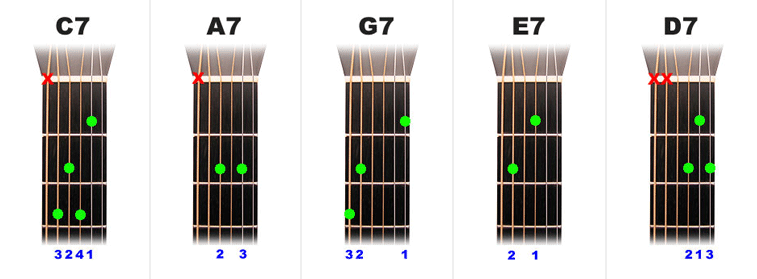The Open 7th Chords (dominant)
When you learn a little more about music theory, you will find that there should really only be one 'dominant 7th' chord in each key, the V chord, the chord built on the fifth degree (I know: boring!) of the scale. It acquires its flat seven naturally. However, in fairly recent times, untutored musicians (mainly blues players) started writing tunes using 7ths for all the chords in their progressions. We became used to the sound, which then filtered into jazz and rock'n'roll, then country and pop music ... ▼
Here are the 'Sevenths', as opposed to 'Major sevenths'. The naming of chords can be quite confusing and inconsistent. The term 'Major Seventh' that applies to the chords on the previous page is used not because the chord itself is major, but because the extra note, the '7', is the the 7th note of the major scale. Those chords always have the abbreviation 'maj' or sometimes 'M' in their symbol. The chords we'll look at here are simply called 'Seventh' and the shorthand symbols can either be '7' or '7th'. They're also referred to as 'dominant sevenths'. We saw that the Major7ths add the 7th note of the major scale to the 1-3-5. Dominant sevenths use the next note down in pitch, the b7.
This note doesn't occur naturally in the major scale, but it does occur naturally in the scale built on the fifth degree which is called 'dominant fifth', hence the term 'dominant'. Don't worry about all this gobbledegook, all you really need to know is how these chords look on the fretboard, which is what I've shown below. If you do like the theory side of it all, you can compare the diagrams with the major sevenths and see that the new note is one fret lower. You will also hear when you play them that they sound quite different. The major sevenths sound pretty, but stable; the sevenths sound more bluesy and they also have a 'pulling' sound about them that seems to want to lead to anther chord.
Here are the 5 open 7th Chords
The green dots show you where to put your finger tips. The red crosses mean 'Don't pluck/play this string'. The blue numbers indicate the best left hand fingers to use.
1 = index | 2 = middle | 3 = ring | 4 = pinkie.

Do I need to mention it yet again? Yes: the important thing to remember about these five chords is that they all have the same quality, or 'flavor', they are all sevenths. They look different because of the way the guitar is tuned and because the strings end at the nut, but (apart from the C7*) they are all made up of the same ingredients, namely the first (1), third (3), fifth (5) and flat seventh (b7) notes of their scale, and therefore have the same sound quality.
*There is no easy way of including the 5 (fifth) in the open C7 chord. However, because guitars have six strings and many chords use more than six tones, it is often the case that some tones need to be omitted from a chord, especially those big 'extended' chords. The fifth is the least missed chord tone and is usually the first to go. So this C7 isn't quite a complete chord, but even though it's 'fifth-less', it still sounds like and functions as a C7 chord.

Join Our Free Trial
Get started today before this once in a lifetime opportunity expires.
